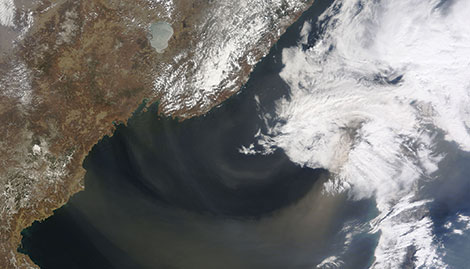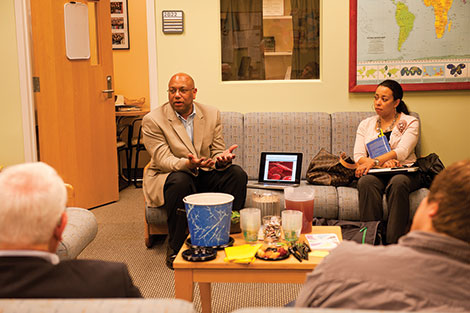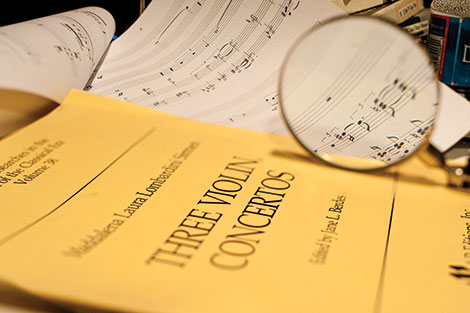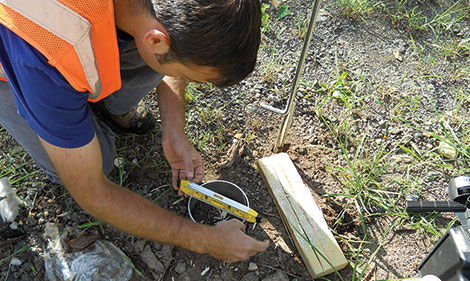PLAYING ITS PARTICLE
Sixty-four million tons of dust and pollution blow across the oceans to North America each year – and our continent itself produces about the same amount on its own. Tracking those particles could prove crucial in assessing changes in the earth’s climate, but scientists have found it difficult to locate and quantify them accurately.
Researchers at NASA’s Goddard Space Flight Center, however, have devised a way to do so using two satellites to draw a three-dimensional picture of airborne particles. In a paper published in Science magazine, the team of researchers asserted that most of what travels to this continent is dust particles, carried as high as six miles up in the atmosphere and blown by winds that disperse them around the world.
Lorraine Remer, a senior research scientist in UMBC’s Joint Center for Earth Systems Technology (JCET), was one of the team of Goddard researchers who devised the system.
“Dust is part of the natural balance,” says Remer, who cites the way that water in clouds condenses around dust particles, affecting the formation and properties of the clouds and thus altering rain patterns, as one example of its importance.
The Goddard researchers examined aerosols – a category of particles that includes both dust (the tiny grains of minerals blown up from deserts and farm lands) and pollution. Scientists know more about the latter (which is produced by industrialization, fires, and transportation) because of its harmful effects on health. Pollution is also more easily measured because it stays closer to the earth’s surface.
Dust, on the other hand, mostly remains high in the atmosphere, and is not a major health issue, says Remer. She and the rest of the team discovered that most of the dust in the skies above North America (between 49 to 77 percent of it) comes from Asia. Africa contributes 15 to 34 percent of that total, with the Middle East adding 7 to 17 percent. Deserts are one major source of dust, and droughts can increase the amount of it.
Remer observes that knowing where dust comes from – and how much there is – can aid our knowledge of climate issues other than rainfall patterns. Dust that falls on mountain ranges can alter how the snow melts and possibly produce “hydrological problems” in regions (including the American West) where that snow melt provides much of the water supply.
Dust also plays a key role in reducing global warming. Because it reflects sunlight, dust particles provide a cooling effect on the climate that mitigates – in a yet undetermined amount – warming trends in the earth’s climate.
Indeed, dust may account for about a third of the Earth’s aerosol reflectivity, which masks some of the effects of warming, says Remer. But she adds that most scientists are dubious about thought experiments that propose adding more dust-like substances (perhaps sulfate particles) to the atmosphere as a sort of “lifeboat maneuver” to further increase reflectivity for a rapidlywarming earth.
“Most people’s reactions are negative, including scientists’,” Remer says. “Scientists don’t like to fuss with the natural world.”
— Joel N. Shurkin
Dust plume over Inner Mongolia beginning its eastward journey over the Sea of Japan. Credit: NASA Earth Observatory/Jeff Schmaltz
REFLECTION AND EMOTION
It’s no surprise that associate professor of psychology Shawn Bediako treasures the sankofa: an image from African folklore that depicts a bird looking backward to retrieve what it needs to move forward. His varied endeavors have led him to do something quite similar, investigating psychology’s past and pushing the discipline into the future.
“Most of the history [of psychology] does not address the contributions that women or people of color have made,” observes Bediako. “Nor does it really address the contributions that people from places other than North America have made. And that’s very significant to me as someone of color.”
Bediako’s initial foray into excavating psychology’s diverse past was organizing a 2008 conference at the University of Cincinnati (where he served on the faculty prior to coming to UMBC) to celebrate the life of Inez Beverly Prosser, the first African American woman to earn a doctoral degree in psychology. The event – as well as his growing interest in widening the narrative of the discipline – helped him eventually to find a place on the advisory board of the Center for the History of Psychology at the University of Akron. As a board member, Bediako not only elevates marginalized voices in psychology’s past, but he also devises ways to work them into his teaching at UMBC.
Finding students who will create psychology’s future is just as important to Bediako, who obtained funding from the American Psychological Association to mentor a diverse group of Baltimore-area high school students with a nascent interest in the discipline.
Exposing those students to psychological research is a key element in Bediako’s efforts. Inspired by a structure created by UMBC professor of chemistry Mike Summers in his award-winning laboratory, Bediako hopes to expand his work with high school students by bringing them into his own research, and creating a system in which they are mentored by undergraduates, who are, in turn, advised by graduate students, and so on. “We don’t just create a pyramid,” states Bediako, who is working with Summers on implementing his vision. “We create a circle of people mentoring and being mentored.”
Interdisciplinarity is also an engine in Bediako’s efforts to infuse psychology – and his own research on attitudes about sickle cell disease –with the power and potential of the latest technology. Using funding supplied by the university, Bediako created partnerships with UMBC’s computer science and information systems departments to enlist students to help him design programs for tablet computers to research the lives of sickle cell patients. The tablets replace traditional surveys, and they promise to provide Bediako with objective and real-time information that researchers previously had no way of collecting.
Like the bird depicted in the sankofa image, Bediako says that looking back gives him a useful perspective on his own work.
“[History] helps me stay connected to this larger history of scholarship and keeps me motivated to discover something,” he says. “At some point down the line, there may be someone looking back here, at the work we’re doing now, and thinking that [work] shifted discussion about what sickle cell disease means.”
— Chelsea Haddaway
TAKING NOTE
“Twenty years ago when I was a young woman composer, I assumed that eventually women would achieve equality in contemporary music programming,” says Linda Dusman, a professor of music at UMBC. “It hasn’t happened.”
Indeed, the field of classical music composition remains male-dominated, with few new works by women composers appearing on orchestral, chamber or solo music programs. In statistics compiled by the group Women’s Philharmonic Advocacy, for instance, works by women accounted for only 0.7 percent of the works reported to the League of American Orchestras from 2001 to 2008.
So with financial assistance from UMBC’s Special Research Assistantship/Initiative Support Fund, Dusman conceived and launched I Resound Press (iresound.umbc.edu) – the first digital press and archive for music by women composers.
“This is my contribution to ending the cycle,” says Dusman.
To inaugurate the press, Dusman selected six composers (in addition to herself ) as featured artists: Sofia Kamayianni, Annea Lockwood, Ruth Lomon, Patrice Repar, Jane Rigler, and fellow UMBC professor of music Anna Rubin. She plans to expand the number of composers over time.
“At first I was going to do a personal website, and then realized that it would be more rewarding to promote the works of many people rather than simply my own,” she recalls.
Dusman says she selected her fellow composers with an ear for “voices that reflected a woman’s experience” across a wide stylistic landscape. “Lockwood and Repar are quite experimental. Ruth Lomon reflects mid-20th century formalism; and Sofia Kamayianni shows a lot of Greek and dramatic/interdisciplinary influences.”
I Resound Press solves a number of complex and often vexing issues surrounding music publication and distribution, digitally presenting handwritten or oversized scores that also might consist of several different kinds of materials. The digital distribution model also provides an opportunity for performers, composers and researchers to preview and purchase scores – in many cases for the first time. Although I Resound press specializes in digital access to handcopied scores, it also contains computer-copied scores, electroacoustic compositions, mixed media works, and audio CDs for purchase.
Dusman points to the contribution of other UMBC colleagues and alumni in I Resound’s launch. Alan Wonneberger, a lecturer in music technology, is the press’ technical director; Jennifer Roberts ’12, music, served as assistant editor before leaving for graduate studies at Bowling Green State University, and Christian Parent ’04, music, designed the press’ website.
The press is also looking to make a sonic splash on campus on Thursday, March 7, when works by I Resound composers will be featured in an evening concert at UMBC’s Fine Arts Recital Hall.
“My current intern, [UMBC sophomore] Nancy Puckett, developed the idea for this concert as a way to promote the press,” says Dusman, who adds that the aim was “to program works that are playable by students, and then to package these works to possibly interest other universities and colleges in doing the program. We are hoping to include a piece by each composer from the press on the program, and it will feature UMBC student pianists, percussionists, flutists, and string players.”
— Thomas Moore
GREEN AND CLEAN
Can Maryland’s green spaces help keep the Chesapeake Bay cleaner?
Stuart S. Schwartz, a senior research scientist at UMBC’s Center for Urban Environmental Research and Education (CUERE) is developing new methods that may help minimize potentially harmful runoff from green spaces into the Chesapeake Bay.
“What we find when you look around at construction sites is the way that we develop the landscape deeply disturbs [the soil],” says Schwartz.
One particular culprit is soil compaction, which allows runoff to flow more readily into the Chesapeake Bay or other bodies of water. So Schwartz and his team have devised a plan to loosen urban soils and mix them with vegetative compost to create a thicker, deeper soil that also allows more rainfall to infiltrate it and be retained in the soil, thus producing less runoff.
Schwartz’s plan adapts “subsoiling” – a technique commonly used in agriculture to break up the shallow compaction of soil that develops when farm vehicles go back and forth across fields. The researchers at CUERE are using deep ripping with heavy steel blades ripping (18 to 24 inches down) to pulverize the soil then they till organic material compost back into the ground.
The technique likely won’t have immediate applications in small residential yards where deep ripping would also tear up water, gas, and electrical utilities, though Schwartz says that in the right conditions (utilities on one side of houses, for instance), a collection of 25 to 50 homeowners on the same street who agreed to have it done might provide the proper economy of scale.
So in the meantime, Schwartz and his colleagues have secured a grant to test their method on vacant lots in Baltimore City where access is easier to obtain – and the researchers can also test other sustainable methods aimed at reducing pollutants even further.
Schwartz says that the tests on vacant lots are “also incorporating biochar, a very specialized form of black carbon, which has a high affinity for binding certain pollutants.”
Indeed, biochar might turn such sample lots (and any other space in which it is employed) into high-performance pollutant filters that will retain hydrocarbons, heavy metals and nutrients above and beyond what a normal soil can hold.
To accelerate the adoption of the deep ripping technique, the CUERE researchers hope to convince developers to use subsoiling at the time of building construction. Though challenges such as demolition debris that might pose constraints to deep ripping do remain, such collaborations would achieve the goal of reducing runoff and also minimize costs, since the technique requires just a little bit of extra time, an inexpensive commodity (compost) and a piece of equipment typically onsite already.
— Nicole Ruediger
Tags: Winter 2013




